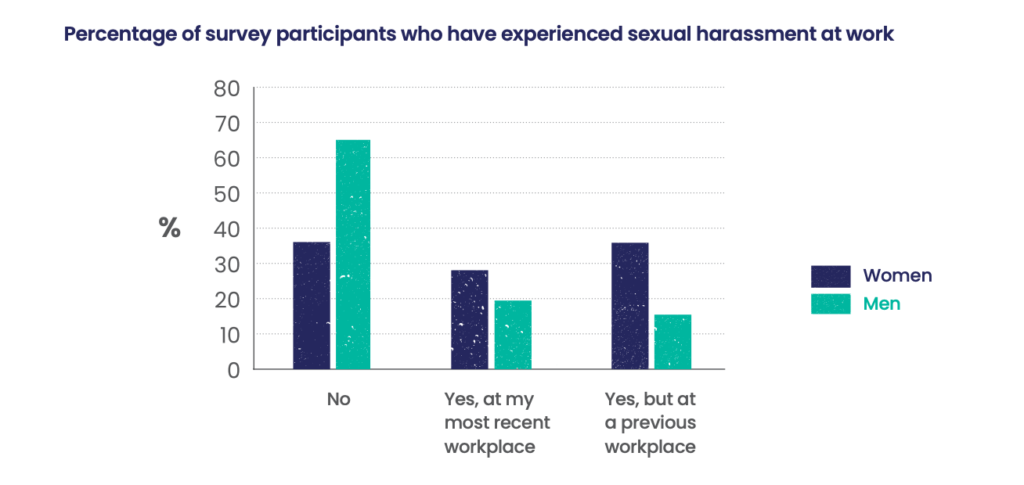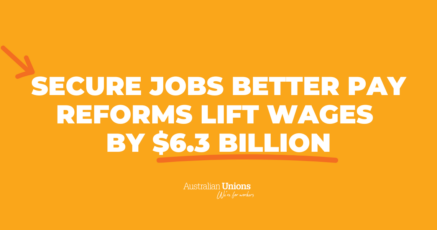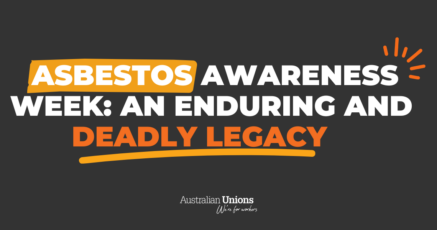When former Liberal Party staffer Brittany Higgins shared her account of sexual assault in the workplace, it sent shockwaves through Parliament and the wider community.
But for many women, what emerged from the headlines was a distressingly familiar story of toxic workplace cultures, unacceptable tolerance of sexual harassment, and a complete failure of those in charge to protect victims.
Online movements like #MeToo and #LetHerSpeak have helped shed light on just how widespread sexual assault and harassment is, with countless women like Ms Higgins going public with their experiences.
These stories have played an important role in raising awareness of the problem, but recent data suggests Australia still has a long way to go to protect women in the workplace.
A 2018 ACTU survey found more than half of female respondents reported having experienced sexual harassment during their working lives. Of these, only 27% reported the incident, with most victims being too scared of negative consequences if they were to report.

“This issue is not one limited to Canberra and Parliament House. Sexual harassment at work is rife across Australia and our current laws are failing to keep workers safe,” said ACTU President Michele O’Neil in response to Ms Higgin’s allegations.
It’s a view supported by the Australian Human Rights Commission. In their Respect@Work report released last year, they stated, “Workplace sexual harassment is prevalent and pervasive: it occurs in every industry, in every location and at every level in Australian workplaces.”
But what exactly is sexual harassment, and what can you do to protect yourself?
What is sexual harassment?
Sexual harassment is a type of harassment that involves unwelcome behaviour of a sexual nature. It can cause physical and mental injury and can result in criminal charges for the perpetrators.
Although sexual harassment can happen to anyone, research shows that women are more likely to be targeted.
What counts as sexual harassment?
Under the Sex Discrimination Act 1984, sexual harassment is:
- making an unwelcome sexual advance, or an unwelcome request for sexual favours; or
- engaging in other unwelcome conduct of a sexual nature.
Every victim’s experience is unique and depends on individual factors. But some common examples include:
- Sexual or suggestive emails, messages, gestures, jokes and comments
- Any unwelcome touching
- Staring or leering
- Brushing up against someone unnecessarily
- Unwanted invitations to go on a date
- Inappropriate comments about someone’s private life or body
- Insults or taunts based on sex or gender
My harasser says it was just a joke, is it still sexual harassment?
The Australian Human Rights Commission reported that one of the most commonly reported types of behaviour were sexually suggestive comments or jokes.
Inappropriate sexual behaviour includes jokes and may still be considered harassment even if you are not the target of the joke
For example, if sexual jokes and crude conversation are common in your workplace, or if inappropriate sexual material is on display, you may feel sexually harassed – even if you are not being directly targeted.
So, what can I do if I’ve been sexually harassed?
Being sexually harassed at work can affect you in different and complex ways. It can make you feel less confident, less capable and more stressed while you are at work. It can also affect your private life, making you feel anxious, irritable and reluctant to return to work.
Just remember, you’re not alone, and there are things you can do about it.
Join your union
Sexual harassment is a work health and safety issue. This means your employer has a legal duty to protect you from sexual harassment at work. If your boss is not meeting this legal obligation, a union can give you the best advice and support. Join your union today.
Contact the Australian Unions Support Centre
The Australian Unions Support Centre provides free and confidential assistance and information on all workplace issues. Browse the Support Centre website to learn more or if you can’t find the answer you’re looking for, give them a call on 1300 486 466 for free and confidential help.
Write it down
Start writing down incidents of sexual harassment as they happen. Creating a diary record of what happens can be useful later if you need to provide evidence about what has been happening, and for how long – especially since you may not always remember things as clearly a few days, weeks or months later.
You should capture the following information:
- The date of the incident, including what might have happened beforehand and afterwards;
- Where did the incident take place?
- Who was there, were there any witnesses (this includes people who may have seen the harassment or anything that happened before or afterwards)?
- What was said, and by whom;
- What happened?
- Why do you feel that what was said or done was bullying, harassment or sexual harassment?
- How did you feel after the incident?
Writing down the details of any incident is really important, but depending on what’s happening, you may also want to take other steps.
Tell someone
Speak to someone you trust at your work about what is happening.
This can either be a colleague you are close to, your Health and Safety Representative or your union delegate or organiser.
Approach the person
If you feel confident, you can approach the harasser and tell them that their behaviour is unacceptable and unwanted. If you are not sure about the best way of doing this, get advice from your union delegate or organiser.
Do not approach the harasser if you feel it could endanger your safety in any way.
Make an internal complaint
If the harassment continues or if you don’t feel comfortable approaching the harasser yourself, you should make a complaint to your manager. If you don’t feel comfortable talking to your manager about the issue, especially if they are the harasser, you can speak to your Health and Safety Representative or to your union delegate, organiser or the Australian Unions Support Centre to help you work out the best person to make a complaint to.
Your employer has a responsibility to provide a safe working environment that is free from sexual harassment. If your manager does not act to stop the harassment, your union can help you work out what to do next.
Make an external complaint
Depending on the nature of the harassment, there a range of external places you can go to for assistance. Your first port of call should be your union, which can provide you with assistance and representation throughout this process.
If you are being, or have been, sexually harassed, you may be able to make a complaint to the Australian Human Rights and Equal Opportunity Commission. Your union can provide you with advice on how to do this.
Contact the Australian Unions Support Centre if you need assistance connecting with a union.
If you or anyone you know needs help:
- 1800 RESPECT on 1800 737 732
- Lifeline on 13 11 14
- BeyondBlue on 1300 22 46 36
- Headspace on 1800 650 890
Please note that the information given here is general information only and is not legal advice. For further assistance, it is recommended you speak to your union or call the Australian Unions Support Centre on 1300 486 466.







SHARE:
What to do if you are sexually harassed at work